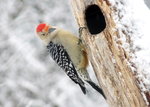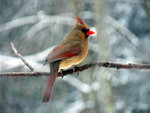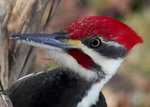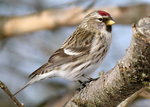



There are almost 2,000 individual Christmas Bird Counts (CBCs) in the U.S. every year between Dec. 14 and Jan. 5. Thousands of citizen scientists go out walking, driving, looking and listening for any and all wild birds they can find on their assigned day, often from before dawn until dark.
Each "count circle" is a geographical circle with a 15-mile diameter, a standard set by the Audubon Society, which collects all the data sent in by all the CBCs. Locally, there are three separate counts: the Minnewaska/Shawangunk circle, the Ulster/Dutchess circle, and the Ashokan/Mohonk circle. The Ashokan/Mohonk been going now for 72 years. Steve Chorvas has been a participant for at least 40 of those years, besides compiling the count data for the last 20.
Chorvas, then, is the man to ask about trend-spotting.
“What we’re counting here in the CBC are permanent residents, the birds that are here year-round,” Chorvas said. As far as that population goes, according to the CBC data, “birds are increasing.” He qualified that statement by saying that there are also increasing numbers of people volunteering to count them. “Birding has become very popular. More people seem to be willing to devote their time in volunteer efforts like this.” With more eyes and ears, more birds get found. “We also have access to more … nature preserves, rail trails that didn’t exist 20 years ago. So that helps a little … [but] by and large, numbers are increasing. You can attribute that to global warming – a lot of birds are expanding their range northwards and spending the winter here in greater numbers.” For example, “Carolina wrens. When I first started doing these counts, it would have been very rare to find one in the CBC in New York state. Now, they’re very common.” Another: the red-bellied woodpecker.”
“There are a few species that seem to have declined,” Chorvas added. What birds are becoming rare locally? The ruffed grouse, once fairly common in the Rondout Valley, is one. “Now they’re pretty much limited to the Catskills … Some think that’s because the coyote population expanded. The graouse nest on the ground.” Another vanishing visitor to feeders is the vividly colorful evening grosbeak. “They used to descend in large flocks and go through your sunflower seed … now, most winters, they don’t seem to be around.”
The CBC, naturally, doesn’t keep track of the neotropical migrants who spend their winters in far southern locales. “Those are the ones that are adversely affected by insect populations,” and some, Chorvas said, are declining along with the numbers of the insects they mainly feed upon, “moths and other pollinators.”
How do the volunteers know they’re not counting the same bird twice? “We divide the circle, which is 15 miles in diameter, into sectors. We assign a field party to each area.” The parties stick to their sector. “That’s another reason to do the count in just one 24-hour period, so the birds don’t shift too much. That pretty much eliminates double counting. With some species, like a large flock of Canada geese that might fly from a cornfield to, let’s say, a body of water, and then back again, we try to keep track of that … If two different groups have the same number of Canada geese, you look at the time of day and you can probably figure out whether they’re counting the same individuals or not,” Chorvas said.
“Hearing is the way to get an accurate count, because many times you’ll hear birds you never end up seeing,” he said. Of course it's not possible to find them all. “Even with the number of people we have, I don’t think we’re even counting 10% of the birds that are out there, probably far less … That’s understood when you analyze [the data].” Not everyone who comes out for the count is an expert; sometimes there are people’s kids, or a group of students. That said, “this year, it was close to a record in the amount of field-party hours.”
Birders like Chorvas are not stopped by weather conditions. They also don't seem to be deterred by lack of sleep.
“We started out about 5 [a.m.] to do some owling, and we stayed out till dark,” reported Mark DeDea, another incredibly dedicated individual who was out counting birds in all three local count circles this year. Doesn’t he get cold? “There’s no such thing as bad weather, just bad clothing,” he quipped. “My wife got me a really good raincoat and all-weather pants, and I used them in all three of the CBCs this year ... Not everybody has to put in the kind of effort I do," DeDea hastened to say. “There’s a lot of older folks who are serious birders. They’re maybe not going to spend whole the day like I do, like a lunatic!” For himself, he considers it “recreation, an elixir to the pandemic.”
DeDea compiles data for the Dutchess-Ulster CBC, which covers part of Hurley and parts north and east of there, on both sides of the Hudson. The write-ups for the counts include weather conditions, numbers of all species found, the number of volunteers, and unusual findings. "It’s all submitted to the National Audubon Society," which keeps track of regional trends across the United States and beyond.
Besides the satisfaction of participating, and the fun of “bagging” birds for your count, “it’s a very nice social activity, too,” said DeDea. "Most years, we’re able to have a compilation get-together. Everybody brings a dish … Let me tell you, we’re all ready to get back to that way of doing things!” He is resourceful when it comes to finding volunteers, drawing on “visiting birders from the Metro area” and people from other clubs. “It’s a nice way to have a little camaraderie between organizations. Each county usually has a bird club, or in the case of Ulster we have a natural history society,” that is, the John Burroughs Natural History Society, of which DeDea happens to be the president.
Nicholas Martin, Minnewaska park educator, heads the Minnewaska/Shawangunk circle, now in its fourth year. “I’ve had really poor weather every time … you’re not really getting a clear picture of what’s there … the birds are hiding, conserving energy,” he said. Minnewaska counts have been “all over the place” so far, ranging from 17,000 to 9,800. “The compiler divides the circle into set areas," Martin explained, with one to five people assigned to cover them. He's had from 37-48 field people in the field. Also, he’s had up to a dozen reporting from their feeders at home, another way to participate. “People can walk or drive around, looking for birds, or stay at home and watch their feeder. Every team’s different ... walking trails, walking roads, driving,” or stopping at places where they know from experience that birds come, like a pond. How to count birds from a moving car? “You’re driving down the road with the window down,” DeDea recounted. “Hey! I hear a flock of chickadees. You pull over.” (It helps to have a passenger.)
Mostly they'll observe common birds like "Canada geese, crows. We do hope to find something unusual, but judging what’s happening with the populations of regular birds tells you a lot about what’s happening with climate change, how birds are adapting to that. We have birds that would typically be gone in the winter that now linger and can survive through the winter, without deep snow cover … we’re seeing trends, and instead of taking eons to change, they’re taking decades."
DeDea was particularly amazed by the “spectacular numbers of robins, due not just to the mild winter but to a very heavy crop of juniper cones that they feed on.” (Interestingly, they also eat the berries of the much-maligned invasive bittersweet, according to Chorvas.) "The robins have been crazy vocal, even singing. I even heard a hermit thrush singing – I’ve never heard one singing in the winter.” Cone-eaters like thrushes, cedar waxwings, bluebirds, "those are all considered 'half-hardy' birds" that would have flown south if the winter were colder.” As a result of the presence in amazing numbers of these half-hardies, 32,334 birds were tallied, setting a new high of individuals, “easily eclipsing our previous record of 26,034 in 2011 and well above the average per count of 16,922,” DeDea wrote in his summary of the Ulster /Dutchess CBC on Dec. 29.
The first Christmas Bird Count, in the year 1900, was conceived as an alternative to an ongoing tradition called the Christmas Side Hunt, wherein people would team up to shoot birds and other game and compete to kill the most. That's a tradition that belongs in the past, but the excitement of the hunt is alive in the citizen scientists who participate in the CBC.
To identify birds by both sight and sound, visit merlin.allaboutbirds.org. Merlin also has a phone app. To learn more about the activities of the John Burroughs Natural History Society, go to jbnhs.org.